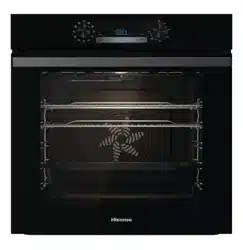Loading ...
Loading ...
Loading ...

General tips and advice for baking
• Remove all unnecessary equipment from the oven during baking
• Use equipment made of heat-resistant non-reflective materials (supplied baking sheets, trays,
and dishes, enamel-coated cookware, tempered glass cookware). Bright-coloured materials
(stainless steel or aluminium) materials reflect heat. As a result, thermal processing of food in them
is less effective.
• Always insert the baking sheets and trays to the end of the guides. When baking on the wire rack,
place the baking dishes or trays in the middle of the rack.
• For optimum food preparation, we recommend observing the guidelines specified in the cooking
table. Choose the lower specified temperature and the shortest specified cooking time. When this
time expires, check the results and then adjust the settings as necessary.
• Unless it is absolutely necessary, do not open the oven door during baking.
• Do not place the baking trays directly onto the oven cavity bottom.
• Do not use the all-purpose deep baking tray on the 1st guide level while the appliance is operating.
• Do not cover the oven cavity bottom or the wire rack with aluminium foil.
• With longer cooking programs, you can switch off the oven approximately 10 minutes before the
end of cooking time to make use of the accumulated heat.
• Always place the baking dishes onto the wire rack.
• When baking on several levels at the same time, insert the all-purpose deep baking tray into the
lower level.
• When cooking according to recipes from older cookbooks, use the bottom and top heater system
(as in conventional ovens) and set the temperature 10 °C lower than specified in the recipe.
• If you are using parchment paper, make sure it is resistant to high-temperatures. Always trim it
accordingly. Parchment paper prevents the food from sticking to the baking sheet and makes it
easier to remove the food from the baking sheet.
• When cooking larger cuts of meat or pastry with higher water content, a lot of steam will be
generated inside the oven, which in turn may condense on the oven door. This is a normal
phenomenon which will not affect the operation of the appliance. After the cooking process, wipe
the door and the door glass dry.
• When baking directly on the wire rack, insert the all-purpose deep tray one level lower to serve
as a drip tray.
• Rapid preheating of the oven: Only preheat the oven if required by the recipe of in the tables in
these instructions for use. If you are using the rapid preheating function, do not insert the food
into the oven until the oven is fully heated. Temperature has a substantial effect on the final result.
Rapid preheating is recommended for delicate cuts of meat (sirloin), and for yeast-leavened and
sponge dough that require a shorter baking time. Heating an empty oven consumes a lot of energy.
Therefore, if possible, we recommend cooking several dishes in succession, or making several
dishes simultaneously.
Dishes that require a fully pre-heated oven are indicated with one asterisk in the table * , while
dishes for which a 5-minute preheat will suffice are indicated with two asterisks ** . In this case,
do not use the rapid preheat mode.
• Slow Bake: Allows slow and controlled cooking at a low temperature. The meat juices are
distributed evenly, and the meat remains juicy and tender. The SlowBake slow cooking method
is suitable for delicate boneless meat cuts. Before slow cooking, sear the meat thoroughly from
all sides in a frying pan.
19
Loading ...
Loading ...
Loading ...
